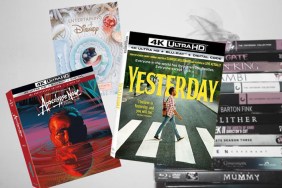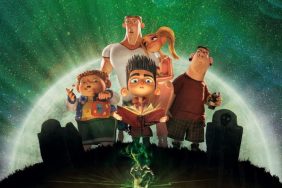Some filmmakers make movies. A precious few make dreams.
Hayao Miyazaki is one of the latter, producing over the last 35 years eleven classics feature films in animation, redefining the medium and inspiring generations of animators in the process. His motion pictures are works of exquisite beauty, lusciously painted and exuberantly brought to life, but beyond that they are tales of philosophical depth and moral complexity. Miyazaki’s films espouse peace and environmentalism whilst exhibiting a keen understanding of exactly how the world moved away from those unassailable ideals.
And now they are all available in one giant set, The Collected Works of Hayao Miyazaki, available exclusive on Amazon. This twelve-disc collection also includes a disc of bonus features, but the films themselves are the real star attraction. Each motion picture has been beautifully transferred with the original Japanese audio track preserved, although the (mostly excellent) American dubs are the default on every disc.
Related: The Best Movie Ever | Studio Ghibli
Every one of Hayao Miyazaki’s films is a classic. Ranking them would be pointless, and grading them in any quantifiable way would reveal little more than personal preference. But for those who may not be entirely familiar with Hayao Miyazaki’s work, we present now an overview of each film and special feature, to give you a better sense of what is in store for you in this mostly impeccable set.
I say “mostly.” I’ll why when we get to Disc Twelve.
[Editor’s Note: Not all images are from the new Blu-ray set.]
Disc One: The Castle of Cagliostro

Toho
Even the great Hayao Miyazaki had to do work-for-hire at the beginning of his career. His first feature as a director was The Castle of Cagliostro, based on the already popular Lupin III series by Monkey Punch, in which Lupin tries to rescue a princess from an evil counterfeiter. Hayao Miyazaki’s version of the character was met with criticism upon the film’s initial release – since it transformed the greedy lothario antihero into a more traditional and romantic protagonist – but his unmistakable flair for beautiful scenery, thrilling set pieces and vibrant character animation shined through.
Nowadays The Castle of Cagliostro is considered one of the best anime films ever produced, and watching the film now, free of fanboy criticism, it’s almost impossible to dispute its quality. The incredible climactic showdown in a giant clock tower in particular has become an influential scene for many animated classics, including The Great Mouse Detective and Batman: The Animated Series.
Disc Two: Nausicaä of the Valley of the Wind

Studio Ghibli
Hayao Miyazaki’s first fully original feature set the template for many of his future productions, establishing a unique fantasy setting for a complex morality tale. Like several of Hayao Miyazaki’s better films, the central conflict of Nausicaä is a fundamental difference of opinion, with a warlike ruler and a peaceful princess struggling to save the world from a poisonous post-apocalyptic environment filled with giant, carnivorous beasts.
In the end empathy reigns supreme, but Miyazaki is careful to explore the mindset of those who believe in their heart of hearts that violence is the only path to peace. Nausicaä is one of Hayao Miyazaki’s more slowly paced productions, often emphasizing mood and atmosphere over the plot, but that just gives the filmmaker more time to focus on another of his recurring themes: the beauty of flight. As the title heroine soars over the wastelands, we soar with her.
Disc Three: Castle in the Sky

Studio Ghibli
Briskly paced and beautifully animated, Castle in the Sky is another handsome production from Hayao Miyazaki. But unlike most of his other films, this brisk pace keeps the audience’s focus on incident and action, leaving less room for his characters to explore their ideas and feelings. The result is a film that is always engaging but perhaps not quite as rich as some of his more beloved productions.
The story is about a young woman with a magical amulet, and the young man who tries to save her from a gang of sky pirates and a corrupt military so they can find a legendary flying city. The action is breathtaking here, and the story has some wonderful turns – especially when one of the villains turns out to have been one of the true heroes all along – but it is arguably one of the filmmaker’s lesser works.
Disc Four: My Neighbor Totoro

Studio Ghibli
Pure magic. After the adventurous Castle in the Sky, Hayao Miyazaki practically abandoned plot altogether with this enchanting tale of two young sisters moving to the country while their mother is in the hospital. In the woods near their house they encounter a race of furry spirits who seem to represent just how kind and wonderful the world can be.
What is perhaps most incredible about My Neighbor Totoro – besides the film’s perfect animation and unmistakable heart – is that it is a children’s film in which the adults may not experience magic for themselves, but never doubt that it really exists. Whereas many kids films emphasize the gap of experience between parents and their children, My Neighbor Totoro never questions for a single moment the existence and importance of situations that would, in any other story, be a fantasy.
My Neighbor Totoro may not even be a fantasy at all. This might very well be the way the world really is. Hopefully that’s true. Regardless, My Neighbor Totoro might very well be Hayao Miyazaki’s finest accomplishment. It is one of the best motion pictures ever made.
Disc Five: Kiki’s Delivery Service

Studio Ghibli
Another fantasy from Hayao Miyazaki without a single villain, and more proof that fantasy stories shouldn’t require us to fantasize about war. Kiki’s Delivery Service is a warm tale about a 13-year-old witch who, according to custom, ventures out on her own to find her path in life. Kiki and her talking cat fly on their broomstick to a coastal city, start their own delivery service, and she becomes a better person.
That’s it.
How endearingly sweet a storyline, and how enchantingly produced. Once again Hayao Miyazaki demonstrates his affection for flight, and he obviously delights in concocting new ways for a young witch to zoom about in the sky, kicking off of buildings like a parkour novice and free falling just for dramatic effect, because flying is fun. Life is fun, people are fun, the world is fun, and a positive attitude in the face of hardship can be a universal cure for what ails us. Kiki’s Delivery Service is the sort of fantasy that should be made more often.
Disc Six: Porco Rosso

Studio Ghibli
Hayao Miyazaki’s obsession with flight takes a surreal turn in Porco Rosso, the tale of a flying ace who is transformed into a pig, but who keeps flying anyway. It’s an odd storyline that Miyazaki himself apparently didn’t find terribly interesting: the film isn’t so much about curing the hero as it is about post-World War I aviation, more sky pirates, and the growing affection between “The Crimson Pig” and his new engineer, a young woman named Fio.
On paper the story of Porco Rosso gets a little more serious, dealing with romantic rivals and fascist governments, but this is a world in which the villainous pirates are more concerned with keeping children happy than kidnapping them. It is another kind tale, but set against a backdrop of actual history that eventually turns Porco Rosso into a bit of a tonal jumble. It’s another lovely piece of animation, but like Castle in the Sky, a little uneven.
Disc Seven: Princess Mononoke

Studio Ghibli
After a series of lighthearted fantasies, Hayao Miyazaki returned with another complex rumination on war and environmentalism with Princess Mononoke, his darkest and most violent production to date. Although it’s nowhere near as graphic and brutal as anime can get, with this film Miyazaki never shies away from the consequences of battle, and limbs do get severed and people do, quite tragically, die.
Prince Ashitaka saves his city from a Boar God, who was transmogrified by a venomous hate after falling prey to new and deadly human weapons. Now Ashitaka bears the curse, and will surely die, but he ventures out anyway in an effort to solve the mystery of the Boar God’s curse and find a way to immerse himself in a war between mankind and forest spirits without letting hate consume him as well. This proves to be nearly impossible, as the feud is turning good people on all sides against each other, until destruction seems like the only way the story can end.
Princess Mononoke is richly characterized, even-handed to all philosophies, and amongst Miyazaki’s most energetically animated work. It carries the weight of the best cinematic fantasy adventure tales ever filmed, arguably earning a place alongside Star Wars and The Lord of the Rings as one of the best examples of the genre.
Disc Eight: Spirited Away

Studio Ghibli
Spirited Away is one of Hayao Miyazaki’s most acclaimed and popular works, which is pretty impressive considering just how remarkably odd it is. It is the story of a young girl whose parents are transformed into pigs and goes to work in a bath house for spirits, and eventually learns that a good attitude and a “can do” attitude can help her overcome any obstacle. Real-life foibles are small potatoes after you yank a bicycle out of a toxic river spirit, that’s for sure.
Before Spirited Away, Hayao Miyazaki’s films always felt grounded by some form of reality. From the time night falls at the beginning of this tale, we are thoroughly immersed in strange situations, bizarre characters and magical rules that are rarely (if ever) explained. Perhaps that is the film’s real power, to throw reality aside and thrust an audience into a new world unlike anything they have ever seen before. The only thing we are allowed to take with us is the moral.
Some people love Spirited Away more than any other Hayao Miyazaki movie. Some might be a little dumbfounded by just how odd it is. Either way this is a unique and fantastic film experience that nobody should pass up.
Disc Nine: Howl’s Moving Castle

Studio Ghibli
Hayao Miyazaki adapts Diana Wynne Jones’s 1986 fantasy novel into a somewhat perplexing, but no less wonderful anime feature. Howl’s Moving Castle is the tale of a wallflower transformed into an old lady, who finds her inner strength while proving her worth to a wizard named Howl, who himself is trapped in the middle of an encroaching war. Eventually her confidence starts breaking her curse, and she begins to realize that the enigmatic Howl might be suffering from a curse of his very own.
The political machinations are a little hard to follow and ultimately, aside from the film’s anti-war message, a little bit besides the point. This is a film about the conflict waging inside all of us, and the power of kindness and understanding and love to bridge those divides. The imagery is among Hayao Miyazaki’s most striking – a mechanical castle crawling across the landscape, a friendly bouncing scarecrow, the unexpected transformations of the characters – but the story is a bit messy. Howl’s Moving Castle is one of Hayao Miyazaki’s most ambitious features, but this time his reach may have slightly exceeded his grasp.
Disc Ten: Ponyo

Studio Ghibli
Ponyo is weird as all hell, which either makes it magical or just off-putting. Your mileage may vary. This unusual interpretation of The Little Mermaid finds a fish falling in love with a young boy, then transforming into a little girl who drinks blood and loves ham and destroys a whole town in a tidal wave that floods the community. It’s just plain baffling, honestly, but somehow Miyazaki keeps the increasingly bizarre situations feeling light and lovable.
It helps that Ponyo has an inviting pastel palette that gives the film a storybook aesthetic. It also helps that it was obviously intended for very young children, who are probably able to forgive the wonky storyline in favor of the overpowering imagery and good intentions. It may or may not help that the theme song that plays over the closing credits is an ear worm of epic proportions. (You will have it stuck in your head for days, weeks, maybe even months.)
Ponyo may be best interpreted as a creative exercise. Few are likely to consider this as one of the filmmaker’s richest cinematic expressions, but everyone is likely to be taken aback by its in-your-face enthusiasm and eccentricity.
Disc Eleven: The Wind Rises

Studio Ghibli
Hayao Miyazaki is retired now, and if The Wind Rises really does turn out to be his last feature, he went out on an impossibly high note. The historical drama tells the story of Jiro Horikoshi, a brilliant Japanese aviator whose innovations were sadly used to develop the Japanese Zero Fighter, an instrument of violence in World War II. Miyazaki spends most of his film making us understand that Jiro Horikoshi’s life, love and passion had nothing to do with violence, but that he did allow the engines of warfare to help bring his dreams to life.
The Wind Rises is a lovely and sad drama even without these complex themes, full of romance and beautiful flight, but few recent films have so delicately balanced the conversation about artistry and real world context. At one point, Jiro Horikoshi is asked about the Egyptian pyramids, which are amongst the world’s great wonders but the result of slave labor. “Which would you choose,” Hirokoshi and the audience are invited to consider, “a world with pyramids or a world without?”
The answers may seem obvious, but often only in retrospect. Hayao Miyazaki allows you to condemn Jiro Horikoshi but not without making damn sure you know where he comes from, and how he came to make the decisions in his life, and why they seemed like the right decisions at the time. And we in turn are forced to wonder whether our own life stories will be transformed by history, or whether we will be allowed to simply live them on our own terms, free from scrutiny.
The Wind Rises is one of Hayao Miyazaki’s most complicated masterpieces, and the perfect end to an unassailable career in feature animation.
Disc Eleven: Bonus Features

Amazon
This, alas, is where The Collected Works of Hayao Miyazaki falls short. This disc contains only a few special features, one of which is Hayao Miyazaki’s farewell press conference, which runs for an hour and a half. If you’ve never seen a press conference before, in its entirety, you may find this feature novel enough to sit through the entire thing. But you will quickly discover that these events can be frustrating and repetitive, and watching Miyazaki shut down some of the most obvious questions ceases to be amusing after a while and becomes a little dreary.
This disc also includes Yuki’s Son, a short pitch reel for a TV series about an orphan girl, filled with tragedy and drama. It’s a great find, and certainly worth watching (especially given the brief running time), but it’s hardly illuminating on its own without more context.
The same could be said for the three episodes of Little Samurai that are also included. This is a strange and violent kids show about a little boy fighting “The Ogre Mask Gang” and perfecting his “Vacuum Tornado” secret move, which he unleashes by yelling. The episodes are from throughout the series, and at least one of them ends on a cliffhanger. They are amusing but they have little in common with any of Hayao Miyazaki’s more personal work.
And that’s it. No documentaries, no commentary tracks, and none of Miyazaki’s other works are in this collection. There are a lot of short films and television episodes that are worth tracking down that didn’t make it into this set. (In particular I recommend Miyazaki’s wrenching music video for “On Your Mark.”)
But at least this isn’t called The Complete Works of Hayao Miyazaki, unlike the so-called “Complete” Star Wars collection which omits the Holiday Special and both Ewok movies. This is merely a collection of Hayao Miyazaki’s works, and they need no supplements to enhance them. These are some of the best and most important animated features in history, and they belong in your collection.
If you already have all of these films – or at least, if you already have the films you wish to own – then you probably won’t want to upgrade. But if your collection is lacking, or if you have someone in your life who doesn’t yet understand the wonders of Hayao Miyazaki, this collection is just about perfect. Beautiful films with beautiful transfers, in both the original language and the (mostly impressive) Disney/Miramax dubs… that’s special enough without any so-called “special features.”
Top Photo: Studio Ghibli
William Bibbiani (everyone calls him ‘Bibbs’) is Crave’s film content editor and critic. You can hear him every week on The B-Movies Podcast and watch him on the weekly YouTube series Most Craved and What the Flick. Follow his rantings on Twitter at @WilliamBibbiani.








